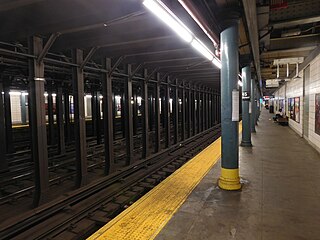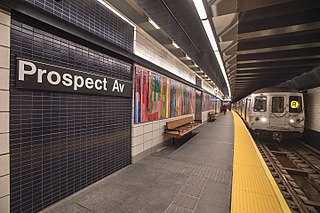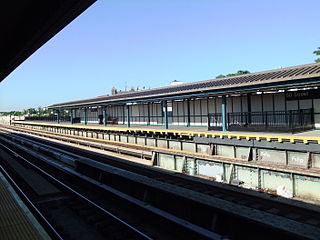
The Winthrop Street station is a station on the IRT Nostrand Avenue Line of the New York City Subway, located in Brooklyn at the intersection of Winthrop Street and Nostrand Avenue. The station is served by the 2 train at all times and the 5 train on weekdays.

The 90th Street–Elmhurst Avenue station is a local station on the IRT Flushing Line of the New York City Subway, located at 90th Street and Elmhurst Avenue in Elmhurst, Queens. It is served by the 7 train at all times.

The Borough Hall/Court Street station is an underground New York City Subway station complex in Brooklyn shared by the BMT Fourth Avenue Line, the IRT Broadway–Seventh Avenue Line and the IRT Eastern Parkway Line. The complex comprises three stations: Borough Hall on the IRT lines and Court Street on the BMT line. The stations are located under Court, Joralemon, and Montague Streets, next to Brooklyn Borough Hall, in the Downtown Brooklyn and Brooklyn Heights neighborhoods of Brooklyn. It is served by the 2, 4, and R trains at all times; the 3 train all times except late nights; the 5 train on weekdays; the N train during late nights; and limited rush-hour W trains.

The Union Street station is a local station on the BMT Fourth Avenue Line of the New York City Subway. It is located at the corner of Fourth Avenue and Union Street in Brooklyn, New York City, serving the communities of Park Slope, Gowanus and Carroll Gardens. It is served by the R train at all times. The D and N trains also stop here during late nights, and some rush-hour W trains stop here in the peak direction.

The 86th Street station is a station on the BMT Fourth Avenue Line of the New York City Subway, located at 86th Street and Fourth Avenue in Bay Ridge, Brooklyn. It is served by the R train at all times.

The 59th Street station is an express station on the BMT Fourth Avenue Line of the New York City Subway. Located at 59th Street and Fourth Avenue in Sunset Park, Brooklyn, it is served by the N and R trains at all times. During rush hours, several W trains also serve the station.

The 75th Avenue station is a local station on the IND Queens Boulevard Line of the New York City Subway. Located at the intersection of 75th Avenue and Queens Boulevard in Forest Hills, Queens, it is served by the F train at all times, the E train at all times except weekday rush hours and middays, and the <F> train during rush hours in the reverse peak direction.

The Bay Ridge Avenue station is a station on the BMT Fourth Avenue Line of the New York City Subway, located at the intersection of Bay Ridge Avenue and Fourth Avenue in Bay Ridge, Brooklyn. It is served by the R train at all times.

The 45th Street station is a local station on the BMT Fourth Avenue Line of the New York City Subway. Located at 45th Street and Fourth Avenue in Sunset Park, Brooklyn, it is served by the R train at all times. The N train also stops here during late nights, and some rush-hour W trains stop here in the peak direction.

The Prospect Avenue station is a local New York City Subway station on the BMT Fourth Avenue Line in Brooklyn. It is located at Prospect Avenue and Fourth Avenue near the convergence of the Gowanus, Greenwood Heights, Park Slope, and South Park Slope neighborhoods. It is served by the R train at all times. The D and N trains also stop here during late nights, and some rush-hour W trains stop here in the peak direction.

The Bay Ridge–95th Street station is the southern terminal station on the BMT Fourth Avenue Line of the New York City Subway. Despite the name, the station is located in the neighborhood of Fort Hamilton at the intersection of 95th Street and Fourth Avenue in southwestern Brooklyn. It is served by the R train at all times. Geographically, this station is the westernmost New York City Subway station.

The 25th Street station is a local station on the BMT Fourth Avenue Line of the New York City Subway. Located at the intersection of 25th Street and Fourth Avenue in Greenwood Heights, Brooklyn, it is served by the R train at all times. The D and N trains also stop here during late nights, and some rush-hour W trains stop here in the peak direction.

The 53rd Street station is a local station on the BMT Fourth Avenue Line of the New York City Subway. Located at 53rd Street and Fourth Avenue in Sunset Park, Brooklyn, it is served by the R train at all times. The N train also stops here during late nights, and some rush-hour W trains stop here in the peak direction.

The 169th Street station is a local station on the IND Queens Boulevard Line of the New York City Subway. Located at the intersection of 169th Street and Hillside Avenue in Queens, it is served by the F train at all times, the <F> train during rush hours in the reverse peak direction, and a few rush-hour E trains to Jamaica–179th Street during p.m. rush hours.

The Avenue I station is a local station on the IND Culver Line of the New York City Subway. Located at the intersection of Avenue I and McDonald Avenue in Midwood, Brooklyn, it is served by the F train at all times and the <F> train during rush hours in the peak direction.

The Liberty Avenue station is a local station on the IND Fulton Street Line of the New York City Subway, located at the intersection of Liberty and Pennsylvania Avenues in East New York, Brooklyn. It is served by the C train at all times except nights, when the A train takes over service.

The Livonia Avenue station is an elevated station on the BMT Canarsie Line of the New York City Subway. Located at the intersection of Livonia and Van Sinderen Avenues at the border of Brownsville and East New York, Brooklyn, it is served by the L train at all times. It opened on June 27, 1906, and is planned to be connected with the IRT New Lots Line's Junius Street station in the 2020s.

The Grand Avenue–Newtown station is a local station on the IND Queens Boulevard Line of the New York City Subway. Located under private property at the northeast corner of the intersection of Grand Avenue, Broadway, and Queens Boulevard in the neighborhood of Elmhurst, Queens, it is served by the M train on weekdays, the R train at all times except nights, and the E and F trains at night.

The 50th Street station is a local station on the BMT West End Line of the New York City Subway, located at the intersection of 50th Street and New Utrecht Avenue in Borough Park, Brooklyn. It is served by the D train at all times. The station opened in 1916, and had its platforms extended in the 1960s.

The Fourth Avenue/Ninth Street station is a New York City Subway station complex shared by the elevated IND Culver Line and the underground BMT Fourth Avenue Line. It is located at the intersection of Ninth Street and Fourth Avenue in Park Slope, Brooklyn and served by the:


























